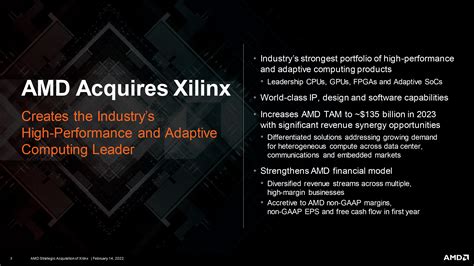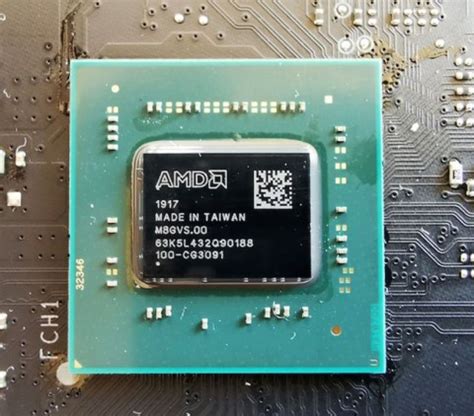Introduction
In a groundbreaking move that sent shockwaves through the technology industry, Advanced Micro Devices (AMD) announced its acquisition of Xilinx, a leading provider of programmable logic devices, for a staggering $35 billion. This AMD-Xilinx acquisition marks a significant milestone in the semiconductor industry and has far-reaching implications for the electronics world. In this article, we will explore the details of the acquisition, its potential impact on the market, and what it means for consumers and businesses alike.
The AMD-Xilinx Acquisition: A Game-Changer
Overview of the Acquisition
On October 27, 2020, AMD announced its intention to acquire Xilinx in an all-stock transaction valued at $35 billion. The deal, which is expected to close by the end of 2021, will create a combined company with a market capitalization of approximately $135 billion. This merger brings together two industry giants, each with a unique set of strengths and expertise.
AMD’s Strengths and Market Position
AMD, founded in 1969, is a global semiconductor company that designs and manufactures high-performance computing and graphics products. The company has a strong presence in the personal computer (PC) and server markets, with its Ryzen processors and Radeon graphics cards gaining significant market share in recent years. AMD’s success can be attributed to its innovative product lineup, competitive pricing, and strategic partnerships with major OEMs and cloud service providers.
Xilinx’s Strengths and Market Position
Xilinx, established in 1984, is a leading provider of programmable logic devices, including field-programmable gate arrays (FPGAs), programmable system-on-chips (SoCs), and adaptive compute acceleration platforms (ACAPs). These devices are used in a wide range of applications, such as automotive, aerospace and defense, data centers, and consumer electronics. Xilinx’s products are known for their flexibility, performance, and power efficiency, making them ideal for complex and demanding workloads.

The Rationale Behind the Acquisition
Complementary Product Portfolios
One of the primary reasons behind the AMD-Xilinx acquisition is the complementary nature of their product portfolios. AMD’s expertise in high-performance CPUs and GPUs, combined with Xilinx’s leadership in programmable logic devices, creates a comprehensive offering that spans the entire spectrum of computing needs. This combination will enable the merged company to address a broader range of customer requirements and tackle more complex challenges in the electronics industry.
Expanding Market Opportunities
The acquisition also opens up new market opportunities for both companies. AMD’s strong presence in the PC and server markets, coupled with Xilinx’s established foothold in the automotive, aerospace, and defense sectors, creates a diversified portfolio that can capitalize on emerging trends and growth areas. For example, the increasing demand for edge computing, 5G networks, and artificial intelligence (AI) applications presents significant growth potential for the combined company.
Synergies and Cost Savings
Another key factor driving the acquisition is the potential for synergies and cost savings. By combining their research and development efforts, manufacturing capabilities, and supply chain networks, AMD and Xilinx can achieve greater economies of scale and improve operational efficiency. This, in turn, can lead to reduced costs, faster time-to-market, and enhanced innovation capabilities.

Impact on the Electronics Industry
Increased Competition in the Semiconductor Market
The AMD-Xilinx acquisition is set to shake up the semiconductor industry, intensifying competition among the major players. With the combined strength of AMD and Xilinx, the merged company will pose a significant challenge to rivals such as Intel and NVIDIA. This heightened competition is likely to drive innovation, lower prices, and improve product offerings for consumers and businesses.
Acceleration of Technology Trends
The acquisition is also expected to accelerate several key technology trends in the electronics industry. These include:
-
Edge Computing: The combined expertise of AMD and Xilinx in high-performance computing and programmable logic devices will enable the development of more advanced edge computing solutions. This will be crucial for applications such as autonomous vehicles, industrial IoT, and smart cities, which require real-time data processing and low-latency responses.
-
5G Networks: Xilinx’s programmable devices are well-suited for the complex signal processing and network virtualization requirements of 5G networks. With AMD’s computing prowess, the merged company will be well-positioned to capitalize on the growing demand for 5G infrastructure and devices.
-
Artificial Intelligence: Both AMD and Xilinx have made significant investments in AI technologies, with AMD’s GPUs and Xilinx’s FPGAs and ACAPs being used in AI accelerators and inference engines. The combined company will have a stronger AI portfolio, enabling it to compete more effectively with NVIDIA and other AI-focused firms.
Potential Challenges and Risks
While the AMD-Xilinx acquisition presents numerous opportunities, it also comes with its fair share of challenges and risks. These include:
-
Integration Complexity: Merging two large and complex organizations is never an easy task. The combined company will need to navigate cultural differences, align business strategies, and integrate disparate technologies and processes. Any missteps in the integration process could lead to delays, cost overruns, and loss of key talent.
-
Regulatory Hurdles: The acquisition will be subject to regulatory approvals from various jurisdictions, including the United States, European Union, and China. Given the current geopolitical tensions and increased scrutiny of large technology mergers, there is a risk that the deal could face regulatory challenges or even be blocked.
-
Market Uncertainties: The semiconductor industry is known for its cyclical nature and sensitivity to macroeconomic factors. The COVID-19 pandemic has introduced additional uncertainties, with supply chain disruptions, shifting consumer demand, and economic slowdowns. The combined company will need to navigate these challenges and adapt to changing market conditions.

Implications for Consumers and Businesses
Enhanced Product Offerings
The AMD-Xilinx acquisition is expected to result in enhanced product offerings for consumers and businesses. The merged company will be able to leverage its combined expertise to develop more advanced and integrated solutions, spanning CPUs, GPUs, FPGAs, and adaptive SoCs. This could lead to more powerful and efficient devices, such as gaming consoles, laptops, servers, and embedded systems.
Potential Price Changes
The impact of the acquisition on product prices is less certain. On one hand, the increased competition and economies of scale could lead to lower prices for consumers and businesses. On the other hand, the consolidation of the industry and the creation of a larger, more dominant player could result in higher prices, particularly in segments where the combined company has a strong market position.
Long-Term Benefits
Despite the potential short-term challenges and uncertainties, the AMD-Xilinx acquisition is likely to yield long-term benefits for the electronics industry and its customers. The combined company will be better positioned to drive innovation, address complex challenges, and meet the evolving needs of the market. This, in turn, could lead to more advanced and efficient electronic devices, faster adoption of emerging technologies, and greater value for consumers and businesses.
Frequently Asked Questions (FAQ)
-
Q: When is the AMD-Xilinx acquisition expected to close?
A: The acquisition is expected to close by the end of 2021, subject to regulatory approvals and other customary closing conditions. -
Q: How will the acquisition affect AMD’s and Xilinx’s existing product lines?
A: AMD and Xilinx have stated that they will continue to support and develop their existing product lines. The acquisition is expected to enhance their offerings by combining their complementary strengths and expertise. -
Q: Will the acquisition result in job losses?
A: AMD and Xilinx have not announced any plans for significant job cuts as a result of the acquisition. However, as with any merger, there may be some redundancies and restructuring in certain areas. -
Q: How will the acquisition impact AMD’s and Xilinx’s stock prices?
A: The announcement of the acquisition caused a short-term increase in both companies’ stock prices. However, the long-term impact will depend on various factors, such as the success of the integration, market conditions, and financial performance of the combined company. -
Q: What are the potential antitrust concerns surrounding the acquisition?
A: Given the size and market position of the combined company, there may be some antitrust concerns from regulators. However, AMD and Xilinx have expressed confidence that the acquisition will be approved, citing the complementary nature of their businesses and the competitive landscape of the semiconductor industry.
Conclusion
The AMD-Xilinx acquisition is a transformative event in the electronics industry, with far-reaching implications for consumers, businesses, and the market as a whole. By bringing together two industry leaders with complementary strengths and expertise, the merged company is poised to drive innovation, accelerate technology trends, and create value for its customers. While there are challenges and risks associated with the acquisition, the potential benefits are significant and could shape the future of the semiconductor industry.
As the acquisition progresses and the combined company begins to execute its strategy, it will be crucial to monitor its impact on the market, competitors, and customers. The success of the AMD-Xilinx acquisition will not only depend on the smooth integration of the two organizations but also on their ability to navigate the complex and ever-changing landscape of the electronics world.

No responses yet